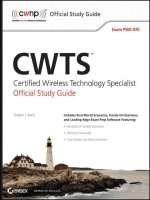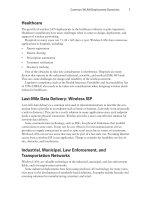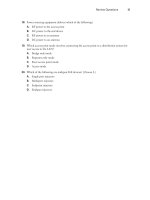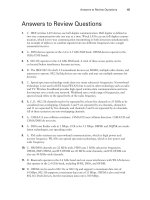Hacking ebook CompTIA pentest study guide exam PT0 001 unknown
Bạn đang xem bản rút gọn của tài liệu. Xem và tải ngay bản đầy đủ của tài liệu tại đây (5.62 MB, 521 trang )
CompTIA
®
PenTest+ Study Guide
CompTIA
®
PenTest+ Study Guide
Exam PT0-001
Mike Chapple
David Seidl
Senior Acquisitions Editor: Kenyon Brown
Development Editor: Jim Compton
Technical Editor: Jeff Parker
Senior Production Editor: Christine O’Connor
Copy Editor: Judy Flynn
Content Enablement and Operations Manager: Pete Gaughan
Production Manager: Kathleen Wisor
Executive Editor: Jim Minatel
Book Designers: Judy Fung and Bill Gibson
Proofreader: Louise Watson, Word One New York
Indexer: Ted Laux
Project Coordinator, Cover: Brent Savage
Cover Designer: Wiley
Cover Image: Getty Images Inc./Jeremy Woodhouse
Copyright © 2019 by John Wiley & Sons, Inc., Indianapolis, Indiana
Published simultaneously in Canada
ISBN: 978-1-119-50422-1
ISBN: 978-1-119-50425-2 (ebk.)
ISBN: 978-1-119-50424-5 (ebk.)
Manufactured in the United States of America
No part of this publication may be reproduced, stored in a retrieval system or transmitted in any form or
by any means, electronic, mechanical, photocopying, recording, scanning or otherwise, except as permitted under Sections 107 or 108 of the 1976 United States Copyright Act, without either the prior written
permission of the Publisher, or authorization through payment of the appropriate per-copy fee to the
Copyright Clearance Center, 222 Rosewood Drive, Danvers, MA 01923, (978) 750-8400, fax (978) 6468600. Requests to the Publisher for permission should be addressed to the Permissions Department, John
Wiley & Sons, Inc., 111 River Street, Hoboken, NJ 07030, (201) 748-6011, fax (201) 748-6008, or online
at />Limit of Liability/Disclaimer of Warranty: The publisher and the author make no representations or warranties with respect to the accuracy or completeness of the contents of this work and specifically disclaim
all warranties, including without limitation warranties of fitness for a particular purpose. No warranty
may be created or extended by sales or promotional materials. The advice and strategies contained herein
may not be suitable for every situation. This work is sold with the understanding that the publisher is not
engaged in rendering legal, accounting, or other professional services. If professional assistance is required,
the services of a competent professional person should be sought. Neither the publisher nor the author
shall be liable for damages arising herefrom. The fact that an organization or Web site is referred to in this
work as a citation and/or a potential source of further information does not mean that the author or the
publisher endorses the information the organization or Web site may provide or recommendations it may
make. Further, readers should be aware that Internet Web sites listed in this work may have changed or
disappeared between when this work was written and when it is read.
For general information on our other products and services or to obtain technical support, please contact
our Customer Care Department within the U.S. at (877) 762-2974, outside the U.S. at (317) 572-3993 or
fax (317) 572-4002.
Wiley publishes in a variety of print and electronic formats and by print-on-demand. Some material
included with standard print versions of this book may not be included in e-books or in print-on-demand.
If this book refers to media such as a CD or DVD that is not included in the version you purchased, you
may download this material at . For more information about Wiley products, visit www.wiley.com.
Library of Congress Control Number: 2018958333
TRADEMARKS: Wiley, the Wiley logo, and the Sybex logo are trademarks or registered trademarks of
John Wiley & Sons, Inc. and/or its affiliates, in the United States and other countries, and may not be used
without written permission. CompTIA and PenTest+ are trademarks or registered trademarks of CompTIA,
Inc. All other trademarks are the property of their respective owners. John Wiley & Sons, Inc. is not
associated with any product or vendor mentioned in this book.
10 9 8 7 6 5 4 3 2 1
This book is dedicated to Ron Kraemer—a mentor, friend,
and wonderful boss.
Acknowledgments
Books like this involve work from many people, and as authors, we truly appreciate the
hard work and dedication that the team at Wiley shows. We would especially like to thank
Senior Acquisitions Editor Kenyon Brown. We have worked with Ken on multiple projects
and consistently enjoy our work with him.
We also greatly appreciated the editing and production team for the book, including
Jim Compton, our developmental editor, whose prompt and consistent oversight got this
book out the door, and Christine O’Connor, our production editor, who guided us through
layouts, formatting, and final cleanup to produce a great book. We’d also like to thank our
technical editor, Jeff Parker, who provided us with thought-provoking questions and technical insight throughout the process. We would also like to thank the many behind-thescenes contributors, including the graphics, production, and technical teams who make the
book and companion materials into a finished product.
Our agent, Carole Jelen of Waterside Productions, continues to provide us with wonderful opportunities, advice, and assistance throughout our writing careers.
Finally, we would like to thank our families, friends, and significant others who support
us through the late evenings, busy weekends, and long hours that a book like this requires
to write, edit, and get to press.
About the Authors
Mike Chapple, PhD, Security+, CISSP, CISA, PenTest+,
CySA+, is an associate teaching professor of IT, analytics, and
operations at the University of Notre Dame. He is also the
academic director of the University’s master’s program in
business analytics.
Mike is a cybersecurity professional with over 20 years of
experience in the field. Prior to his current role, Mike served
as senior director for IT service delivery at Notre Dame, where
he oversaw the University’s cybersecurity program, cloud computing efforts, and other areas. Mike also previously served as
chief information officer of Brand Institute and an information security researcher with the
National Security Agency and the U.S. Air Force.
Mike is a frequent contributor to several magazines and websites and is the author or
coauthor of more than 25 books, including CISSP Official (ISC) 2 Study Guide, CISSP
Official (ISC) 2 Practice Tests, CompTIA CySA+ Study Guide: Exam CS0-001, and
CompTIA CySA+ Practice Tests: Exam CS0-001, all from Wiley, and Cyberwarfare:
Information Operations in a Connected World (Jones and Bartlett, 2014).
Mike offers free study groups for the PenTest+, CySA+, Security+, CISSP, and SSCP certifications at his website, certmike.com.
David Seidl, CISSP, PenTest+, CySA+, GCIH, GPEN, is
the senior director for campus technology services at the
University of Notre Dame. As the senior director for CTS,
David is responsible for Amazon AWS cloud operations, virtualization, enterprise storage, platform and operating system
support, database and ERP administration and services, identity and access management, application services, enterprise
content management, digital signage, labs, lecterns, and academic printing and a variety of other services and systems.
During his over 22 years in information technology, David
has served in a variety of leadership, technical, and information security roles, including
leading Notre Dame’s information security team as director of information security. He has
written books on security certification and cyberwarfare, including coauthoring CompTIA
CySA+ Study Guide: Exam CS0-001, CompTIA CySA+ Practice Tests: Exam CS0-001,
and CISSP (ISC) 2 Official Practice Tests from Wiley and Cyberwarfare: Information
Operations in a Connected World (Jones and Bartlett, 2014).
David holds a bachelor’s degree in communication technology and a master’s degree in
information security from Eastern Michigan University.
Contents at a Glance
Introductionxxv
Assessment Test
lvi
Chapter 1
Penetration Testing
Chapter 2
Planning and Scoping Penetration Tests
31
Chapter 3
Information Gathering
57
Chapter 4
Vulnerability Scanning
99
Chapter 5
Analyzing Vulnerability Scans
137
Chapter 6
Exploit and Pivot
181
Chapter 7
Exploiting Network Vulnerabilities
223
Chapter 8
Exploiting Physical and Social Vulnerabilities
259
Chapter 9
Exploiting Application Vulnerabilities
283
Chapter 10
Exploiting Host Vulnerabilities
321
Chapter 11
Scripting for Penetration Testing
363
Chapter 12
Reporting and Communication
405
Answers to Review Questions
425
Appendix
1
Index447
Contents
Introductionxxv
Assessment Test
Chapter
1
lvi
Penetration Testing
1
What Is Penetration Testing?
2
2
Cybersecurity Goals
Adopting the Hacker Mind-Set
4
Reasons for Penetration Testing
5
Benefits of Penetration Testing
5
Regulatory Requirements for Penetration Testing
6
Who Performs Penetration Tests?
8
Internal Penetration Testing Teams
8
External Penetration Testing Teams
9
Selecting Penetration Testing Teams
9
The CompTIA Penetration Testing Process
10
Planning and Scoping
11
11
Information Gathering and Vulnerability Identification
Attacking and Exploiting
12
Reporting and Communicating Results
13
The Cyber Kill Chain
13
Reconnaissance15
Weaponization15
Delivery16
Exploitation16
Installation16
Command and Control
16
Actions on Objectives
17
Tools of the Trade
17
Reconnaissance19
Vulnerability Scanners
20
21
Social Engineering
Credential-Testing Tools
21
Debuggers21
Software Assurance
22
Network Testing
22
Remote Access
23
Exploitation23
Summary23
Exam Essentials
24
xvi
Chapter
Contents
2
Lab Exercises
Activity 1.1: Adopting the Hacker Mind-Set
Activity 1.2: Using the Cyber Kill Chain
Review Questions
25
25
25
26
Planning and Scoping Penetration Tests
31
35
Scoping and Planning Engagements
Assessment Types
36
White Box, Black Box, or Gray Box?
36
38
The Rules of Engagement
Scoping Considerations: A Deeper Dive
40
Support Resources for Penetration Tests
42
Key Legal Concepts for Penetration Tests
45
Contracts45
Data Ownership and Retention
46
Authorization46
Environmental Differences
46
Understanding Compliance-Based Assessments
48
Summary50
Exam Essentials
51
Lab Exercises
52
Review Questions
53
Chapter
3
Information Gathering
57
Footprinting and Enumeration
60
OSINT61
Location and Organizational Data
64
Infrastructure and Networks
67
Security Search Engines
72
Active Reconnaissance and Enumeration
74
Hosts75
Services75
81
Networks, Topologies, and Network Traffic
Packet Crafting and Inspection
83
Enumeration84
Information Gathering and Code
88
89
Information Gathering and Defenses
Defenses Against Active Reconnaissance
90
Preventing Passive Information Gathering
90
Summary90
Exam Essentials
91
Lab Exercises
92
Activity 3.1: Manual OSINT Gathering
92
Activity 3.2: Exploring Shodan
93
Activity 3.3: Running a Nessus Scan
93
Review Questions
94
Contents
Chapter
4
Vulnerability Scanning
xvii
99
102
Identifying Vulnerability Management Requirements
Regulatory Environment
102
Corporate Policy
106
106
Support for Penetration Testing
Identifying Scan Targets
106
Determining Scan Frequency
107
109
Configuring and Executing Vulnerability Scans
Scoping Vulnerability Scans
110
Configuring Vulnerability Scans
111
Scanner Maintenance
117
Software Security Testing
119
Analyzing and Testing Code
120
Web Application Vulnerability Scanning
121
Developing a Remediation Workflow
125
Prioritizing Remediation
126
Testing and Implementing Fixes
127
Overcoming Barriers to Vulnerability Scanning
127
Summary129
Exam Essentials
129
Lab Exercises
130
Activity 4.1: Installing a Vulnerability Scanner
130
Activity 4.2: Running a Vulnerability Scan
130
Activity 4.3: Developing a Penetration Test
Vulnerability Scanning Plan
131
Review Questions
132
Chapter
5
Analyzing Vulnerability Scans
Reviewing and Interpreting Scan Reports
Understanding CVSS
Validating Scan Results
False Positives
Documented Exceptions
Understanding Informational Results
Reconciling Scan Results with Other Data Sources
Trend Analysis
Common Vulnerabilities
Server and Endpoint Vulnerabilities
Network Vulnerabilities
Virtualization Vulnerabilities
Internet of Things (IoT)
Web Application Vulnerabilities
137
138
142
147
147
147
148
149
149
150
151
161
167
169
170
xviii
Contents
Summary172
173
Exam Essentials
Lab Exercises
174
Activity 5.1: Interpreting a Vulnerability Scan
174
174
Activity 5.2: Analyzing a CVSS Vector
Activity 5.3: Developing a Penetration Testing Plan
175
Review Questions
176
Chapter
6
Exploit and Pivot
181
184
Exploits and Attacks
Choosing Targets
184
Identifying the Right Exploit
185
Exploit Resources
188
Developing Exploits
189
Exploitation Toolkits
191
Metasploit192
PowerSploit198
Exploit Specifics
199
RPC/DCOM199
PsExec199
PS Remoting/WinRM
199
WMI200
Scheduled Tasks and cron Jobs
200
SMB201
RDP202
Apple Remote Desktop
203
VNC203
X-Server Forwarding
203
Telnet203
SSH204
Leveraging Exploits
204
Common Post-Exploit Attacks
204
Privilege Escalation
207
208
Social Engineering
Persistence and Evasion
209
Scheduled Jobs and Scheduled Tasks
209
Inetd Modification
210
Daemons and Services
210
Back Doors and Trojans
210
New Users
211
Pivoting211
Covering Your Tracks
212
Summary213
Exam Essentials
214
Contents
Lab Exercises
Activity 6.1: Exploit
Activity 6.2: Discovery
Activity 6.3: Pivot
Review Questions
Chapter
7
Exploiting Network Vulnerabilities
xix
215
215
215
216
217
223
226
Conducting Network Exploits
VLAN Hopping
226
Network Proxies
228
228
DNS Cache Poisoning
Man-in-the-Middle229
NAC Bypass
233
DoS Attacks and Stress Testing
234
236
Exploiting Windows Services
NetBIOS Name Resolution Exploits
236
240
SMB Exploits
Exploiting Common Services
240
SNMP Exploits
241
SMTP Exploits
242
FTP Exploits
243
Samba Exploits
244
Wireless Exploits
245
Evil Twins and Wireless MITM
245
247
Other Wireless Protocols and Systems
RFID Cloning
248
Jamming249
Repeating249
Summary250
Exam Essentials
251
Lab Exercises
251
251
Activity 7.1: Capturing Hashes
Activity 7.2: Brute-Forcing Services
252
Activity 7.3: Wireless Testing
253
Review Questions
254
Chapter
8
Exploiting Physical and Social Vulnerabilities
Physical Facility Penetration Testing
Entering Facilities
Information Gathering
Social Engineering
In-Person Social Engineering
Phishing Attacks
259
262
262
266
266
267
269
xx
Contents
Website-Based Attacks
270
270
Using Social Engineering Tools
Summary273
Exam Essentials
274
275
Lab Exercises
Activity 8.1: Designing a Physical Penetration Test
275
Activity 8.2: Brute-Forcing Services
276
Activity 8.3: Using BeEF
276
278
Review Questions
Chapter
9
Exploiting Application Vulnerabilities
283
Exploiting Injection Vulnerabilities
287
Input Validation
287
Web Application Firewalls
288
SQL Injection Attacks
289
Code Injection Attacks
292
Command Injection Attacks
293
Exploiting Authentication Vulnerabilities
293
294
Password Authentication
Session Attacks
295
298
Kerberos Exploits
Exploiting Authorization Vulnerabilities
299
Insecure Direct Object References
299
Directory Traversal
300
File Inclusion
301
Exploiting Web Application Vulnerabilities
302
Cross-Site Scripting (XSS)
302
Cross-Site Request Forgery (CSRF/XSRF)
305
Clickjacking305
Unsecure Coding Practices
306
306
Source Code Comments
Error Handling
306
Hard-Coded Credentials
307
308
Race Conditions
Unprotected APIs
308
308
Unsigned Code
Application Testing Tools
308
Static Application Security Testing (SAST)
309
Dynamic Application Security Testing (DAST)
310
Mobile Tools
313
Summary313
Exam Essentials
313
Contents
Lab Exercises
Activity 9.1: Application Security Testing Techniques
Activity 9.2: Using the ZAP Proxy
Activity 9.3: Creating a Cross-Site Scripting Vulnerability
Review Questions
Chapter
10
Exploiting Host Vulnerabilities
xxi
314
314
314
315
316
321
325
Attacking Hosts
Linux325
Windows331
338
Cross-Platform Exploits
Remote Access
340
SSH340
Netcat and Ncat
341
341
Proxies and Proxychains
Metasploit and Remote Access
342
342
Attacking Virtual Machines and Containers
Virtual Machine Attacks
343
Container Attacks
344
Physical Device Security
345
Cold-Boot Attacks
345
Serial Consoles
345
JTAG Debug Pins and Ports
346
Attacking Mobile Devices
347
348
Credential Attacks
Credential Acquisition
348
349
Offline Password Cracking
Credential Testing and Brute-Forcing Tools
350
Wordlists and Dictionaries
351
Summary352
Exam Essentials
353
354
Lab Exercises
Activity 10.1: Dumping and Cracking the Windows SAM
and Other Credentials
354
Activity 10.2: Cracking Passwords Using Hashcat
355
Activity 10.3: Setting Up a Reverse Shell
and a Bind Shell
356
Review Questions
358
Chapter
11
Scripting for Penetration Testing
363
Scripting and Penetration Testing
364
Bash365
PowerShell366
xxii
Contents
Ruby367
Python368
Variables, Arrays, and Substitutions
368
Bash370
PowerShell371
Ruby371
Python372
Comparison Operations
372
373
String Operations
Bash375
PowerShell376
Ruby377
Python378
Flow Control
378
Conditional Execution
379
384
For Loops
While Loops
389
394
Input and Output (I/O)
Redirecting Standard Input and Output
394
Error Handling
395
Bash395
PowerShell396
Ruby396
Python396
Summary397
397
Exam Essentials
Lab Exercises
398
398
Activity 11.1: Reverse DNS Lookups
Activity 11.2: Nmap Scan
398
Review Questions
399
Chapter
12
Reporting and Communication
The Importance of Communication
Defining a Communication Path
Communication Triggers
Goal Reprioritization
Recommending Mitigation Strategies
Finding: Shared Local Administrator Credentials
Finding: Weak Password Complexity
Finding: Plain Text Passwords
Finding: No Multifactor Authentication
Finding: SQL Injection
Finding: Unnecessary Open Services
405
408
408
408
409
409
411
411
413
413
414
415
Contents
xxiii
Writing a Penetration Testing Report
415
Structuring the Written Report
415
Secure Handling and Disposition of Reports
417
418
Wrapping Up the Engagement
Post-Engagement Cleanup
418
Client Acceptance
419
419
Lessons Learned
Follow-Up Actions/Retesting
419
Attestation of Findings
419
Summary420
420
Exam Essentials
Lab Exercises
421
Activity 12.1: Remediation Strategies
421
Activity 12.2: Report Writing
421
Review Questions
422
Appendix
Answers to Review Questions
425
Chapter 1: Penetration Testing
Chapter 2: Planning and Scoping Penetration Tests
Chapter 3: Information Gathering
Chapter 4: Vulnerability Scanning
Chapter 5: Analyzing Vulnerability Scans
Chapter 6: Exploit and Pivot
Chapter 7: Exploiting Network Vulnerabilities
Chapter 8: Exploiting Physical and Social Vulnerabilities
Chapter 9: Exploiting Application Vulnerabilities
Chapter 10: Exploiting Host Vulnerabilities
Chapter 11: Script for Penetration Testing
Chapter 12: Reporting and Communication
426
427
429
431
433
434
436
438
440
442
444
445
Index447
Introduction
The CompTIA PenTest+ Study Guide: Exam PT0-001 provides accessible explanations
and real-world knowledge about the exam objectives that make up the PenTest+ certification. This book will help you to assess your knowledge before taking the exam, as well as
provide a stepping stone to further learning in areas where you may want to expand your
skill set or expertise.
Before you tackle the PenTest+ exam, you should already be a security practitioner.
CompTIA suggests that test-takers should have intermediate-level skills based on their
cybersecurity pathway. You should also be familiar with at least some of the tools and techniques described in this book. You don’t need to know every tool, but understanding how
to use existing experience to approach a new scenario, tool, or technology that you may not
know is critical to passing the PenTest+ exam.
CompTIA
CompTIA is a nonprofit trade organization that offers certification in a variety of IT areas,
ranging from the skills that a PC support technician needs, which are covered in the A+
exam, to advanced certifications like the CompTIA Advanced Security Practitioner, or
CASP, certification. CompTIA divides its exams into three categories based on the skill
level required for the exam and what topics it covers, as shown in the following table:
Beginner/Novice
Intermediate
Advanced
IT Fundamentals
Network+
CASP
A+
Security+
CySA+
PenTest+
CompTIA recommends that practitioners follow a cybersecurity career path that begins
with the IT fundamentals and A+ exam and proceeds to include the Network+ and Security+
credentials to complete the foundation. From there, cybersecurity professionals may choose
the PenTest+ and/or Cybersecurity Analyst+ (CySA+) certifications before attempting the
CompTIA Advanced Security Practitioner (CASP) certification as a capstone credential.
The CySA+ and PenTest+ exams are more advanced exams, intended for professionals
with hands-on experience who also possess the knowledge covered by the prior exams.
CompTIA certifications are ISO and ANSI accredited, and they are used throughout
multiple industries as a measure of technical skill and knowledge. In addition, CompTIA
certifications, including the Security+ and the CASP, have been approved by the U.S. government as Information Assurance baseline certifications and are included in the State
Department’s Skills Incentive Program.
xxvi
Introduction
The PenTest+ Exam
The PenTest+ exam is designed to be a vendor-neutral certification for penetration testers. It
is designed to assess current penetration testing, vulnerability assessment, and vulnerability
management skills with a focus on network resiliency testing. Successful test-takers will
prove their ability plan and scope assessments, handle legal and compliance requirements,
and perform vulnerability scanning and penetration testing activities using a variety of
tools and techniques, and then analyze the results of those activities.
It covers five major domains:
1. Planning and Scoping
2. Information Gathering and Vulnerability Identification
3. Attacks and Exploits
4. Penetration Testing Tools
5. Reporting and Communication
These five areas include a range of subtopics, from scoping penetration tests to performing host enumeration and exploits, while focusing heavily on scenario-based learning.
The PenTest+ exam fits between the entry-level Security+ exam and the CompTIA
Advanced Security Practitioner (CASP) certification, providing a mid-career certification
for those who are seeking the next step in their certification and career path while specializing in penetration testing or vulnerability management.
The PenTest+ exam is conducted in a format that CompTIA calls “performance-based
assessment.” This means that the exam uses hands-on simulations using actual security
tools and scenarios to perform tasks that match those found in the daily work of a security
practitioner. There may be multiple types of exam questions, such as multiple-choice, fillin-the-blank, multiple-response, drag-and-drop, and image-based problems.
CompTIA recommends that test-takers have three or four years of information security–
related experience before taking this exam and that they have taken the Security+ exam or
have equivalent experience, including technical, hands-on expertise. The exam costs $346
in the United States, with roughly equivalent prices in other locations around the globe.
More details about the PenTest+ exam and how to take it can be found at
/>
Study and Exam Preparation Tips
A test preparation book like this cannot teach you every possible security software package, scenario, and specific technology that may appear on the exam. Instead, you should
focus on whether you are familiar with the type or category of technology, tool, process, or
scenario presented as you read the book. If you identify a gap, you may want to find additional tools to help you learn more about those topics.
Introduction
xxvii
Additional resources for hands-on exercises include the following:
■■
■■
■■
■■
■■
Exploit-Exercises.com provides virtual machines, documentation, and challenges covering a wide range of security issues at />Hacking-Lab provides capture-the-flag (CTF) exercises in a variety of fields at
/>The OWASP Hacking Lab provides excellent web application–focused exercises at
/>PentesterLab provides a subscription-based access to penetration testing exercises at
/>The InfoSec Institute provides online capture-the-flag activities with bounties for written explanations of successful hacks at />
Since the exam uses scenario-based learning, expect the questions to involve analysis
and thought rather than relying on simple memorization. As you might expect, it is impossible to replicate that experience in a book, so the questions here are intended to help you
be confident that you know the topic well enough to think through hands-on exercises.
Taking the Exam
Once you are fully prepared to take the exam, you can visit the CompTIA website to purchase your exam voucher:
www.comptiastore.com/Articles.asp?ID=265&category=vouchers
CompTIA partners with Pearson VUE’s testing centers, so your next step will be to
locate a testing center near you. In the United States, you can do this based on your address
or your zip code, while non-U.S. test-takers may find it easier to enter their city and country.
You can search for a test center near you at
/>
Now that you know where you’d like to take the exam, simply set up a Pearson VUE
testing account and schedule an exam:
/>
On the day of the test, take two forms of identification, and make sure to show up with
plenty of time before the exam starts. Remember that you will not be able to take your notes,
electronic devices (including smartphones and watches), or other materials in with you.
After the PenTest+ Exam
Once you have taken the exam, you will be notified of your score immediately, so you’ll
know if you passed the test right away. You should keep track of your score report with
your exam registration records and the email address you used to register for the exam. If
you’ve passed, you’ll receive a handsome certificate, similar to the one shown here:
xxviii
Introduction
Maintaining Your Certification
CompTIA certifications must be renewed on a periodic basis. To renew your certification,
you can either pass the most current version of the exam, earn a qualifying higher-level
CompTIA or industry certification, or complete sufficient continuing education activities to
earn enough continuing education units (CEUs) to renew it.
CompTIA provides information on renewals via their website at
/>
When you sign up to renew your certification, you will be asked to agree to the CE program’s Code of Ethics, to pay a renewal fee, and to submit the materials required for your
chosen renewal method.
A full list of the industry certifications you can use to acquire CEUs toward renewing
the PenTest+ can be found at
/>
Introduction
xxix
What Does This Book Cover?
This book is designed to cover the five domains included in the PenTest+ exam:
Chapter 1: Penetration Testing Learn the basics of penetration testing as you begin an
in-depth exploration of the field. In this chapter, you will learn why organizations conduct
penetration testing and the role of the penetration test in a cybersecurity program.
Chapter 2: Planning and Scoping Penetration Tests Proper planning is critical to a penetration test. In this chapter you will learn how to define the rules of engagement, scope,
budget, and other details that need to be determined before a penetration test starts.
Details of contracts, compliance and legal concerns, and authorization are all discussed so
that you can make sure you are covered before a test starts.
Chapter 3: Information Gathering Gathering information is one of the earliest stages of
a penetration test. In this chapter you will learn how to gather open-source intelligence
(OSINT) via passive means. Once you have OSINT, you can leverage the active scanning
and enumeration techniques and tools you will learn about in the second half of the chapter.
Chapter 4: Vulnerability Scanning Managing vulnerabilities helps to keep your systems
secure. In this chapter you will learn how to conduct vulnerability scans and use them as an
important information source for penetration testing.
Chapter 5: Analyzing Vulnerability Scans Vulnerability reports can contain huge amounts
of data about potential problems with systems. In this chapter you will learn how to read
and analyze a vulnerability scan report, what CVSS scoring is and what it means, as well
as how to choose the appropriate actions to remediate the issues you have found. Along the
way, you will explore common types of vulnerabilities, their impact on systems and networks, and how they might be exploited during a penetration test.
Chapter 6: Exploit and Pivot Once you have a list of vulnerabilities, you can move on to
prioritizing the exploits based on the likelihood of success and availability of attack methods. In this chapter you will explore common attack techniques and tools and when to use
them. Once you have gained access, you can pivot to other systems or networks that may
not have been accessible previously. You will learn tools and techniques that are useful for
lateral movement once you’re inside of a network’s security boundaries, how to cover your
tracks, and how to hide the evidence of your efforts.
Chapter 7: Exploiting Network Vulnerabilities Penetration testers often start with network
attacks against common services. In this chapter you will explore the most frequently attacked
services, including NetBIOS, SMB, SNMP, and others. You will learn about man-in-themiddle attacks, network-specific techniques, and how to attack wireless networks and systems.
Chapter 8: Exploiting Physical and Social Vulnerabilities Humans are the most vulnerable part of an organization’s security posture, and penetration testers need to know how
to exploit the human element of an organization. In this chapter you will explore social
engineering methods, motivation techniques, and social engineering tools. Once you know
how to leverage human behavior, you will explore how to gain and leverage physical access
to buildings and other secured areas.
xxx
Introduction
Chapter 9: Exploiting Application Vulnerabilities Applications are the go-to starting
point for testers and hackers alike. If an attacker can break through the security of a web
application and access the backend systems supporting that application, they often have the
starting point they need to wage a full-scale attack. In this chapter we examine many of the
application vulnerabilities that are commonly exploited during penetration tests.
Chapter 10: Exploiting Host Vulnerabilities Attacking hosts relies on understanding
operating system–specific vulnerabilities for Windows and Linux as well as common problems found on almost all operating systems. In this chapter you will explore privilege escalation, OS-specific exploits, sandbox escape, physical device security, credential capture,
and password recovery tools. You will also explore a variety of tools you can leverage to
compromise a host or exploit it further once you have access.
Chapter 11: Scripting for Penetration Testing Scripting languages provide a means to
automate the repetitive tasks of penetration testing. Penetration testers do not need to be
software engineers. Generally speaking, pen-testers don’t write extremely lengthy code or
develop applications that will be used by many other people. The primary development skill
that a penetration tester should acquire is the ability to read fairly simple scripts written
in a variety of common languages and adapt them to their own unique needs. That’s what
we’ll explore in this chapter.
Chapter 12: Reporting and Communication Penetration tests are only useful to the organization if the penetration testers are able to effectively communicate the state of the organization to management and technical staff. In this chapter we turn our attention to that
crucial final phase of a penetration test: reporting and communicating our results.
Practice Exam Once you have completed your studies, the practice exam will provide you
with a chance to test your knowledge. Use this exam to find places where you may need to
study more or to verify that you are ready to tackle the exam. We’ll be rooting for you!
Appendix: Answers to Chapter Review Questions The Appendix has answers to the
review questions you will find at the end of each chapter.
Objective Mapping
The following listing summarizes how the major Pentest+ objective areas map to the chapters in this book. If you want to study a specific domain, this mapping can help you identify
where to focus your reading.
Planning and Scoping: Chapter 2
Information Gathering and Vulnerability Identification: Chapters 3, 4, 5, 6, 10
Attacks and Exploits: Chapters 6, 7, 8, 9, 10
Penetration Testing Tools: Chapters 3, 4, 5, 6, 7, 8, 9, 10, 11, 12
Reporting and Communications: Chapter 12
Later in this introduction you’ll find a detailed map showing where every objective topic
is covered.
Introduction
xxxi
The book is written to build your knowledge as you progress through it, so starting at
the beginning is a good idea. Each chapter includes notes on important content and practice
questions to help you test your knowledge. Once you are ready, a complete practice test is
provided to assess your knowledge.
Study Guide Elements
This study guide uses a number of common elements to help you prepare. These include the
following:
Summaries The summary section of each chapter briefly explains the chapter, allowing
you to easily understand what it covers.
Exam Essentials The exam essentials focus on major exam topics and critical knowledge
that you should take into the test. The exam essentials focus on the exam objectives provided by CompTIA.
Chapter Review Questions A set of questions at the end of each chapter will help you
assess your knowledge and whether you are ready to take the exam based on your knowledge of that chapter’s topics.
Lab Exercises The lab exercises provide more in-depth practice opportunities to expand
your skills and to better prepare for performance-based testing on the PenTest+ exam.
Real-World Scenarios The real-world scenarios included in each chapter tell stories and provide examples of how topics in the chapter look from the point of view of a security professional. They include current events, personal experience, and approaches to actual problems.
Interactive Online Learning Environment
The interactive online learning environment that accompanies CompTIA PenTest+ Study
Guide: Exam PT0-001 provides a test bank with study tools to help you prepare for the
certification exam—and increase your chances of passing it the fi rst time! The test bank
includes the following elements:
Sample Tests All of the questions in this book are provided, including the assessment test,
which you’ll find at the end of this introduction, and the chapter tests that include the review
questions at the end of each chapter. In addition, there is a practice exam. Use these questions to
test your knowledge of the study guide material. The online test bank runs on multiple devices.
Flashcards Questions are provided in digital flashcard format (a question followed by a
single correct answer). You can use the flashcards to reinforce your learning and provide
last-minute test prep before the exam.
Other Study Tools A glossary of key terms from this book and their defi nitions is available as a fully searchable PDF.
Go to to register and gain
access to this interactive online learning environment and test bank with
study tools.

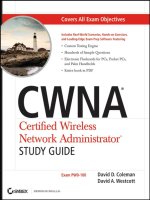

![comptia security+ study guide & practice exam, 2nd ed. [exam jk0-010]](https://media.store123doc.com/images/document/14/rc/ig/medium_iga1395720654.jpg)

